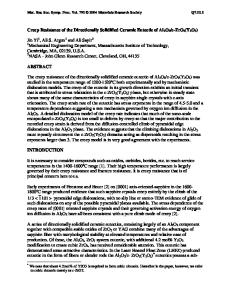Synthesis of Eu-doped (Gd,Y) 2 O 3 transparent optical ceramic scintillator
- PDF / 256,704 Bytes
- 4 Pages / 612 x 792 pts (letter) Page_size
- 50 Downloads / 371 Views
Gyuseong Cho Department of Quantum and Nuclear Engineering, Korea Advanced Institute of Science and Technology (KAIST), 373-1 Kusong-dong, Yusong, Taejon 305-701, Korea (Received 4 June 2003; accepted 21 October 2003)
A novel process for transparent oxide ceramic scintillator with a composition of Gd1.94-xYxEu0.06O3 was developed. The process consists of a glycine–nitrate combustion synthesis of nano-sized starting powder and subsequent controlled sintering and annealing steps. The organic molecules remaining in the as-combusted powder were efficiently removed by the combined heat-treatment at vacuum and air atmospheres. Hot-pressed ceramic scintillators show transparent optical state and high light output. Transparent optical ceramic scintillator with a high content of Gd (up to 80 mol%) was fabricated by the process. The measured light output of Gd1.54Y0.4Eu0.06O3 ceramic scintillator was about two times higher that that of CdWO4 single crystal.
In a typical radiation detection system, the scintillator plays the key role of converting the incident energy of ionizing radiation into scintillation light photons, then the emitted lights are collected by the under-laid photosensor. This specific application requires an ideal scintillator that has high light output, fast decay property, low afterglow, and so forth. Recently, a large number of new scintillator systems has been reviewed,1 resulting, in part, with the development of a new class of scintillator: the polycrystalline ceramic scintillator.2 Discrete CdWO4 single crystals are generally used in medical/industrial x-ray computed tomography (CT). Newly developed ceramic scintillators offer uniform codoping on a molecular level with special additives and a complex composition that cannot be obtained by singlecrystal methods. A typical shortcoming of polycrystalline ceramic as a discrete scintillation element is its low optical transmittance due to microstructural heterogeneities, such as pores and grain-boundaries in the polycrystalline body. Light photons generated by the scintillation mechanism can be practically utilized when they successfully escape from the discrete scintillator element. Lowered optical transmittance by light scattering results a)
Present address: Graduate School of East-West Medical Science, Kyung Hee University, 1 Seochun, Kiheung, Yongin, 449-701, Korea. b) Address all correspondence to this author. e-mail: [email protected] J. Mater. Res., Vol. 19, No. 2, Feb 2004
http://journals.cambridge.org
Downloaded: 14 Jul 2014
in a decreased light escape probability and, thus, finally lowers light output. Only a few kinds of ceramics, such as Gd3Ga5O12:(Cr3+,Ce),3,4 Gd2O2S:(Pr,Ce,F),5,6 and (Gd,Y)2O3:Eu,7 have successfully been prepared as a transparent ceramic scintillator because the perfect elimination of pores is very difficult through the normal sintering step. To achieve highly transparent ceramic scintillator, it is necessary to have a specific scintillator ceramic powder that is nanocrystalline in size, of high purity, has a high spec
Data Loading...











